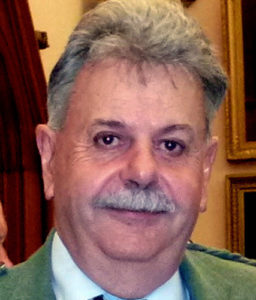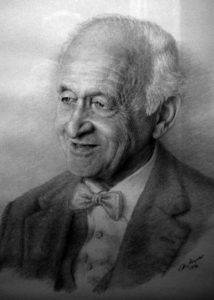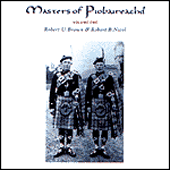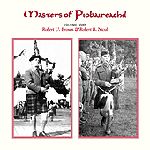
The Masters of Piobaireachd series comprising 10 CDs was an initiative of Norman Matheson and Robert Wallace. As each CD was released, Norman sent a copy to the late James Campbell who responded with letters of analytical content, extracts of which appeared in Piping Press from March 2015.
For those pipers who have the CD collection, the letters are of interest, and to retain them along with their collection would be wise. This article is an attempt to help realise the importance of the ‘Masters of Piobaireachd‘ series and the letters. Those involved, R U Brown, R B Nicol and James Campbell were significant to the study and playing of piobaireachd. With the passage of time, their memory, knowledge and the contribution they made may diminish or be lost to future generations.
Early in the correspondence James wrote, ‘The enormous value of the ‘Masters of Piobaireachd’ series is that it perpetuates John MacDonald’s teaching ….. the ‘Masters’ series is, and will be, a bulwark against the process of revisionism which, in one form or another, seems to obtrude in every generation.’

‘A bulwark against the process of revisionism.’ I would suggest that James Campbell would defend the right of individuals to play the music in any way they wished, but at the time of his writing this there were pipers engaged in what seemed to amount to their relying on the mathematical accuracy of timing of the old sources such as those written by Donald MacDonald and others, with a suggestion that the music was played, and had to be played, literally.
In these scores , echoing beats are written in a different style to later publications, and the GED motifs we term as cadences, differ, some with each note a demi-semi-quaver. In D MacDonald’s published book these figures are termed ‘appoggiatura’. Some pipers may strictly adhere to the notation of these old sources and that’s their choice – but the results, in a lot of cases, are radical and arguably musically doubtful. I recall a leading player commenting along the lines that having studied some of the old sources, he was not surprised that piobaireachd playing went into decline. The Piobaireachd Society had been initiated at the turn of the 19th century to rescue it.
The old sources such as the Donald MacDonald, Peter Reid and MacArthur are important and have been acknowledged as such by compilers in the recent and not so recent past. Our most comprehensive single collection of ceol mor in staff notation is, however, the work of Angus MacKay. Subsequent compilers have followed his format whilst acknowledging Donald MacDonald’s settings or style albeit to limited degree.
These styles and settings include some attractive turns and later editors absorbed them into Angus MacKay’ settings but used his style of writing. The other old sources were also considered in the editing of tunes. The mixing of settings and styles has to be done with thought and in a seamless way. (All of that said, Angus MacKay’s notation, if followed closely, is not exactly as we play it. As with all piobaireachd scores it is a rough guide; the long notes often not as long as we would like them, the short notes, not short enough.)
 The term rubato is used to describe note relationship, the borrowing of time from one note and adding it to another. In addition piobaireachd is not in strict tempo and the notation requires interpretive consideration beyond what is written. That is why teachers are required to assist with expression and timing. It is naive to think, or claim, that what is written in the old sources is an accurate portrayal of what was actually played by pipers of that era. I suspect that James Campbell’s views of ‘revisionism’ were simply that those old sources could not be relied on as a complete answer to what was played by pipers. If that is correct, he was not alone in this view.
The term rubato is used to describe note relationship, the borrowing of time from one note and adding it to another. In addition piobaireachd is not in strict tempo and the notation requires interpretive consideration beyond what is written. That is why teachers are required to assist with expression and timing. It is naive to think, or claim, that what is written in the old sources is an accurate portrayal of what was actually played by pipers of that era. I suspect that James Campbell’s views of ‘revisionism’ were simply that those old sources could not be relied on as a complete answer to what was played by pipers. If that is correct, he was not alone in this view.
The late Archie Kenneth commented on Donald MacDonald along the lines of, ‘We might know what Donald MacDonald did, but we don’t know how he did it.’ This does not in any way demean the value of Donald MacDonald’s music. Paraphrasing slightly, William Ross writes in his 1885 book, ‘All the run down grace notes in MacDonald’s Piobaireachd ought to be played as written with a rest on the E grace note.’ This refers to the cadence motifs mentioned above. (He gives the example of the Princes Salute.) He goes on, ‘If those rules laid down were adhered to in all the tunes in MacDonald’s book, the objections most pipers had (have) to them would to some extent be corrected.’ He would probably mean ‘addressed’ rather than ‘corrected.’
This might mean that with these small changes MacDonald’s settings could be better accepted and played more widely. A tune from Donald MacDonald’s book which I am surprised is not played more is the Lament for John Garve MacLeod of Raasay. If this is because of the ‘cadence’ or run down gracenote timing , or the other non-orthodox gracing, it is a loss. Competition is our main performance platform, and to announce that you are to play such a tune from the Donald MacDonald setting would perhaps raise the expectation that the score was to be rigidly adhered to with the interpretation subjugated to mathematical timings. There are differences of opinion on this approach and it is often the topic when such tunes are ‘set.’
The Masters of Piobaireachd series is of great help and importance in assisting pipers in interpreting the music in general, but its greater benefit may be in its guidance as to the idiom of piobaireachd as it has come down to us.  That said, and as we read in the letters, James Campbell was not dogmatic in his approach. He makes this point early and with some emphasis in his correspondence. In common with his father’s similar stance, James consciously strove to avoid dogma: the inflexible and strongly held notions of rights and wrongs that dominate piobaireachd interpretation.
That said, and as we read in the letters, James Campbell was not dogmatic in his approach. He makes this point early and with some emphasis in his correspondence. In common with his father’s similar stance, James consciously strove to avoid dogma: the inflexible and strongly held notions of rights and wrongs that dominate piobaireachd interpretation.
For example, referring to the content of Volume 3 of MoP, James wrote ‘There is a part of Bob Brown’s introductory remarks which struck me as being open to comment. Bob Brown emphasised that all the old pipers played in exactly the same way. In the sense that they were all agreed on basics, I would certainly concur, but would dissent from any suggestion that there was complete unanimity on all matters of taste and interpretation. John MacDonald’s own interpretations were apt to vary from year to year and it would be contrary to the nature of things if there were no divergence in taste among ‘the old pipers’. The chameleon element in John MacDonald’s make up was dealt with by Frank Richardson in his joint publication with Seamus MacNeill entitled ‘Piobaireachd and its Interpretation’. Frank recognised that John MacDonald would on occasion teach something in one lesson and something else in another, but he argued that all this meant was that in playing piobaireachd we are expressing feelings and emotions which may not remain fixed and immutable through the years.’
• To be continued. Read the original articles here.
















Recent Comments